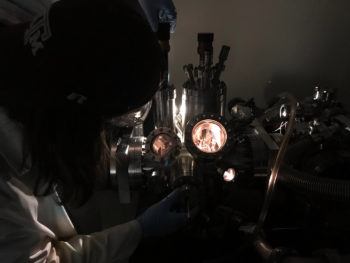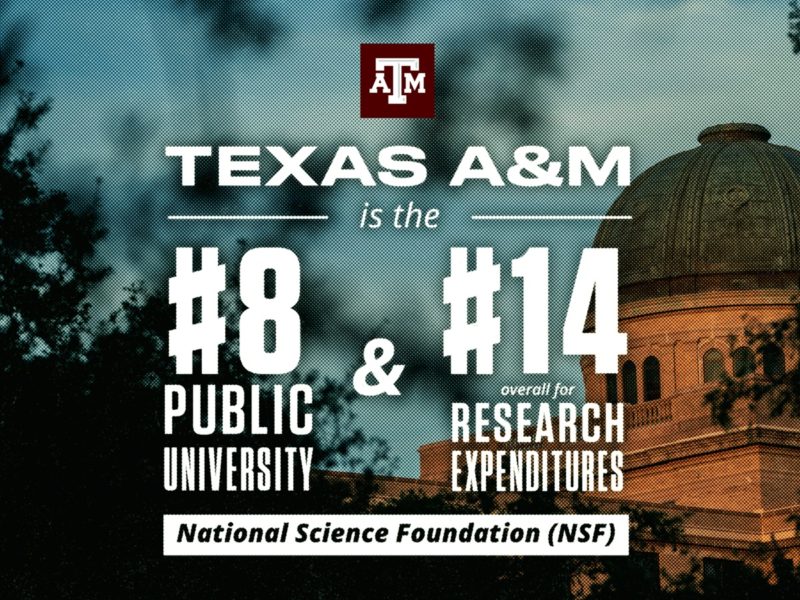National Science Foundation Awards Chemistry Department $1.8 Million Grant

A multi-institution team of scientists led by Texas A&M University chemist James D. Batteas has been awarded a $1.8 million grant to establish the NSF Center for the Mechanical Control of Chemistry (CMCC), one of three new Phase I Centers for Chemical Innovation (CCI) funded through the National Science Foundation Division of Chemistry.
According to the NSF, Centers for Chemical Innovation bring together researchers with diverse expertise to support high risk, transformative science to energize the chemistry research community to take on grand challenges and to creatively engage the public in science while integrating research with education both internally and through multiple outreach activities. The CCI Program supports projects that are too complex and multi-faceted for individuals or small groups of researchers to tackle on their own.
Batteas, who holds the D. Wayne Goodman Professorship in the Texas A&M Department of Chemistry and is an affiliated faculty member in the Texas A&M Department of Materials Science and Engineering, serves as the principal investigator for the CMCC. He is joined by co-investigators Jonathan R. Felts from the Texas A&M Department of Mechanical Engineering, Adam Braunschweig from the Advanced Science Research Center at The Graduate Center, CUNY, Robert Carpick and Andrew Rappe from the University of Pennsylvania, Danna Freedman from Northwestern University and Ashlie Martini from the University of California, Merced, who together bring critical expertise in chemistry, physics, materials science and engineering mechanics to the project.
As the first CCI to be funded in Texas and one of 30 created since the program began in 2012, the CMCC seeks to better understand how the precise application of mechanical forces can be used to alter chemical reaction rates and pathways at surfaces and interfaces. One of the CMCC’s primary goals is to develop quantitative models for mechanochemical synthesis that will have a significant impact on the synthesis of materials, ranging from everyday commodity chemicals, to novel materials for advanced electronics, to pharmaceuticals.
“Mechanochemistry is where chemistry and mechanics meet,” Batteas said. “By compressing or grinding molecules between surfaces, the forces applied can actually help drive reactions between the molecules. This can be used to carry out reactions at low temperatures and without solvents, reducing chemical waste. While this can be a very efficient way of doing chemistry, the outcomes are often unpredictable. In some cases, materials can even be formed that cannot be made through traditional methods, and this of course makes us ask, why and how do we take advantage of that? This is where the CMCC comes in — to bridge the knowledge gap that previously has impeded this from becoming an enabling technology for the chemistry community.”
The use of mechanical force to drive chemistry dates to antiquity, but developing it into a reliable method for chemical synthesis largely has been ignored because the tools to investigate how the application of force affects reactions were until recently highly underdeveloped. To that end, the CMCC is creating a new toolbox that will allow researchers to define and control the forces applied to molecules in precise ways.
In partnership with Eastman and Dow Chemical Companies, the center will seek to apply the transformative knowledge of mechanochemistry it will develop to industrial scale processes to enable new approaches for more energy efficient, more selective and safer chemical syntheses.
The CCI Program is structured in two phases — an initial award supporting a center’s scientific, management and infrastructure development en route to an opportunity for $20 million in subsequent funding, based on a demonstrated capacity for sustainable large-scale science and transformative impact in chemistry.
At the heart of the CMCC is the training of a diverse cadre of graduate and undergraduate students in chemistry, physics, mechanics and materials science who will play key roles in center research and outreach activities. Current plans include a mechanochemistry-themed STEM summer camp for high school students, science history exhibits, entrepreneurship opportunities, and training in both technology transfer strategies and public policy.
“The cross-functional training these students will receive will provide them with a significant advantage when pursuing industrial careers,” said Dawn Mason, Global External Innovation Manager with Eastman Chemical Company. “This is one of the reasons we chose to engage with the CMCC team on this innovative project.”
Since 2018, Batteas and Felts have also served as lead investigators for a Texas A&M X-grant, Mastering Friction to Reduce Current and Future Energy Demands, funded during the initial round of the 10-year, $100 million President’s Excellence Fund initiative and providing a springboard to developing the CMCC.
Batteas notes that the development of new mechanically-driven chemistries is paramount to creating new solutions for controlling friction, which could have massive implications for energy savings.
“A key element in controlling friction is the ability to tune chemical reactions that occur in sliding contacts,” Batteas said. “Thus, we hope the fundamental knowledge of force-driven chemical reactions that the CMCC will reveal might provide insight into these processes as well.”
Learn more about the Center for Chemical Innovation (CCI) Program or the NSF Division of Chemistry.
This article by Shana K. Hutchins originally appeared on the College of Science website.





